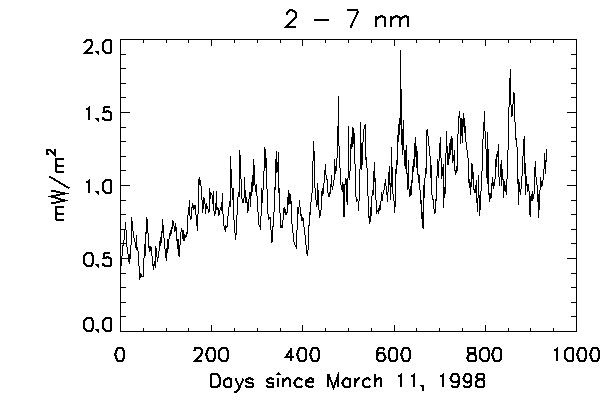The SNOE SXP Data
The SNOE SXP Data Website
An overview of the SNOE SXP calibration and data reduction is presented by:
Bailey, S. M, T. N. Woods, C. A. Barth, and S. C. Solomon, R. Korde, L. R. Canfield, Measurements of the Solar Soft X-ray Irradiance by the Student Nitric Oxide Explorer: First Analysis and Underflight Calibrations, J. Geophys. Res., 105, A12, 27179, 2000.
Some initial results using the SXP data as input to modeling studies is presented by:
Solomon, S. C., S. M. Bailey, and T. N. Woods, Effect of Solar Soft X-rays in the Lower Ionosphere, Geophys, Res., Lett., 28, 2149, 2001.
The Solar X-ray Photometer (SXP) on the SNOE spacecraft has the primary objective of determining the solar soft x-ray irradiance energy input to the upper atmosphere for studies of how that energy input controls nitric oxide abundances. The SXP has made daily measurements of the solar soft x-ray irradiance between 2 and 20 nm since March 11, 1998. The available data product is 935 days of SNOE SXP measurements of the integrated 2 to 7 nanometer irradiance. Other data are also available in the data set, and will be explained below. The image below is a plot of the available data.

The layout of the SNOE SXP data set is as follows.
There are 8 columns, 2 of which are SNOE data products.
TIME TIME SNOE 2-7nm SNOE 2-7nm F10.7 F10.7 Lyman Ap YYYYDDD Year.Frac Measured 1 A.U. ave Alpha mW/m^2 mW/m^2 p/sec/cm^2 1998070 1998.190 0.447 0.453 99.4 103.7 3.89E+11 28 1998071 1998.193 0.471 0.477 100.3 103.7 3.89E+11 14 1998072 1998.196 0.455 0.460 103.7 103.8 3.88E+11 12 1998073 1998.198 0.494 0.500 118.2 103.8 3.94E+11 10 1998074 1998.201 0.543 0.549 131.6 103.9 3.98E+11 20 1998075 1998.204 0.591 0.597 122.6 103.9 3.99E+11 12 1998076 1998.207 0.591 0.597 124.3 104.0 3.95E+11 8 1998077 1998.209 0.623 0.629 125.9 104.1 4.01E+11 4 1998078 1998.212 0.633 0.638 123.5 104.3 4.05E+11 4 1998079 1998.215 0.682 0.688 125.5 104.6 4.07E+11 8
Column 1: Time, in YYYYDDD format
Column 2: Time, in Year.Fraction_of_year format
Column 3: SNOE SXP 2 – 7 nm solar irradiance (mW / m^2)
Column 4: SNOE SXP 2 – 7 nm data, adjusted to 1 A.U.
Column 5: F10.7 daily data (Ottawa/Penticton radio flux)
Column 6: F10.7 81-day average data (Ottawa Penticton radio flux)
Column 7: UARS SOLSTICE Lyman Alpha (photons / sec / cm^2)
Column 8: Fredericksburg Ap geomagnetic activity index
NOTE to MSIS users
MSISE-90 is Hedin’s two-dimensional thermospheric model, which provides estimates of the temperature of the atmosphere and of the number density of seven prevalent species (H, He, N, O, N2, O2, and Ar). It uses the 10.7 cm radio flux (for the previous day, and a 81-day smooth centered on the requested day) and the Ap geomagnetic indices as input.
For full details on the MSISE-90 model see:
Hedin, A, MSIS-86 Thermosphere Model, J. Geophys. Res., 92, 4649-4662, 1987.
and
Hedin, A, Extension of the MSIS Thermosphere Model into the Middle and Lower Atmosphere J. Geophys. Res., 96, 1159-1172, 1991.
